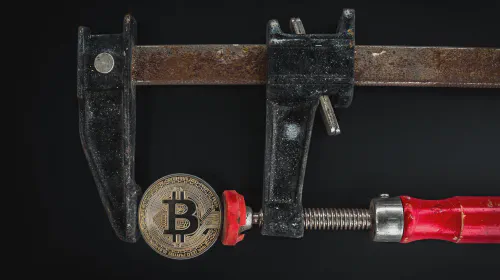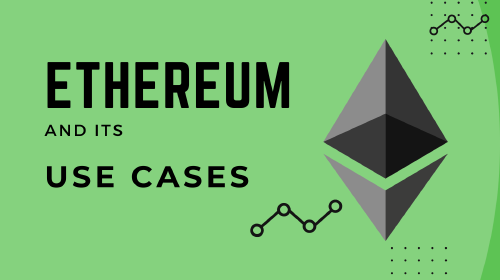Why Can There Only Be 21 Million Bitcoins? Impact of Bitcoin's Fixed Supply
Salomon Kisters
Apr 8, 2022This post may contain affiliate links. If you use these links to buy something we may earn a commission. Thanks!
There’s a light that shines bright in the finance world, and it won’t go out - it’s called Bitcoin.
The cryptocurrency’s popularity exploded in the past couple of years.
This mainly happened in times of distress and crisis, and this is what fascinates everyone.
Bitcoin’s ability to remain a strong asset, at the same time uncorrelated to the traditional markets, is boosting its popularity.
This is making the digital coin enjoy the spotlight as a safe haven and a hedge against inflation.
Bitcoin’s inventor, Satoshi Nakamoto, capped the number of coins at 21 million, and a lot of people who are new in the crypto space are wondering why.
There are a few explanations for which Satoshi might have done this, and we’ll analyze the most intriguing ones below.
These versions have to do with scarcity and inflation control. There’s also the money-replacing theory and an alternative as well.
Check out the most important details about these theories.
Bitcoin’s limited 21 million supply
Just like a lot of other digital assets, Bitcoin has been built by its creator around the concept of a finite supply.
This means that Satoshi has set a fixed upper limit regarding the number of Bitcoins that can ever come into existence.
He set the Bitcoin supply upper limit at exactly 21 million.
In the case of other digital assets, this number varies.
For instance, Ripple’s XRP has a fixed supply of 100 billion, while the anonymity coin Monero (XMR) has a lower fixed supply of 18.9 million.
Scarcity and inflation control
Bitcoin’s limited supply is a massive advantage for the coin because it keeps it scarce.
The scarcer an asset is, the more valuable it can get.
Keeping Bitcoin scarce can ensure that the value of the digital asset can hold steady for years to come. This is also one of the reasons for which Bitcoin is usually called digital gold as well.
Just like gold, we only have a certain amount of Bitcoins in existence.
More than that, it’s really important to understand that by keeping the number of Bitcoin capped at 21 million, inflation can be controlled.
We are referring to the inflation that can arise from an unlimited supply of coins.
In order to control inflation, Satoshi embedded a fixed supply of the digital asset into the network’s code.
This limited supply is the one that makes Bitcoin a scarce asset, and it’s the main trigger that can boost the coin’s price in the future.
Just think about it – there can only be 21 million Bitcoins in existence, and this will ensure a steady flow of liquidity.
The coin will also be minted at a fixed rate. Bitcoin is mined by miners who are solving complex mathematical puzzles in order to verify and validate blocks of transactions that occur in the network.
Creating new crypto using a Proof-of-Stake (PoS) consensual algorithm is called minting.
Proof-of-Work (PoW) coins come into existence via the process called mining.
Both terms were created from real-world coin making. For instance, silver and gold are mined out of the ground, and then they are minted into coins that will enter circulation.
Understating inflation
Inflation is on the rise everywhere, especially since the world is hopping from one crisis to another.
As inflation grows, people are always looking to protect their savings from the devaluing effects that it brings. Inflation mirrors the rising prices of goods and services.
When we see such surging prices, the purchasing power of the masses decreases. This means that more fiat money is required to buy goods and services that you would have been able to buy for lower amounts a while ago.
There are various reasons for which inflation can rise in a society, and these involve macro and micro factors.
But, overall, most experts have already agreed that sustained inflation occurs when there is an increased supply of fiat currency in circulation that is not matching the economic growth of that specific country.
Bitcoin is a hedge against inflation
CNBC recently published an article in which they describe how Bitcoin is a great hedge against inflation.
It’s important to start by highlighting the fact that a good hedge against inflation is able to appreciate in value. This should happen even as the purchasing power of fiat currency is going down.
Throughout history, gold and real estate used to be the standard assets that protected people against inflation.
Now, Bitcoin is the star. It has managed to work great as a hedge against inflation so far, and it delivers massive returns to investors.
As CNBC’s article notes, the main factor that makes Bitcoin the best hedge against inflation is exactly the limited supply of 21 million Bitcoin.
The hard cap was embedded by Satoshi into Bitcoin’s source code.
You should also note that since then, there have already been generated 19 million coins. There are only 2 million to go.
Another issue worth mentioning is that there’s no one who can change the source code of Bitcoin in order to boost the supply.
There’s no excess supply, and the coins that are already in existence will become scarce. The increased demand that we’ll see over time will turn out to increase the price of Bitcoin.
The asset’s portability is also worth mentioning because, unlike gold, it can travel from one corner of the world to another in seconds. Bitcoin is amazing for the unbanked masses as well.
Rising inflation triggers a boost in crypto mass adoption
The rising inflation has a positive result in terms of crypto: it can trigger more digital asset adoption.
Just recently, MicroStrategy’s CEO Michael Saylor who is also a Bitcoin maximalist, revealed his thoughts on the matter.
He believes that an increase in inflation will weaken the global currencies, and it will also end up boosting the crypto mass adoption.
He explained that a surge in prices would impact the whole economy and public debt.
The Bitcoin evangelist recommends BTC as a strong hedge against inflation. He also talks about Bitcoin as a store of value to financial institutions, investors, and economists.
What happens after all Bitcoin is mined
So far, 19 million Bitcoins have already been mined. The last two million that are left will take the most due to a reduction feature.
This is a feature that’s been added by Satoshi, and it refers to the fact that the number of bitcoin each block is producing is reduced by half every four years.
The cycle will continue until there is no more Bitcoin left to mine – this is estimated by experts to be in 2140.
Effects on miners and consumers, and traders
After all Bitcoins are mined, we have to note the effect that this will have on miners and consumers/traders.
Miners are awarded block rewards and transaction fees for their part in the network for solving complex mathematical problems.
When the hard cap of the supply of BTC is reached, miners will not be receiving BTC for producing new blocks, and they will only be getting the transaction fees for taking part in the network.
These fees will be able to make up for the missing block rewards.
The effect on consumers and traders will be significant, as we already said above. Bitcoin will become more and more scarce, and this will lead to a buying frenzy.
The FOMO (fear of missing out) sets in more and more, and the asset’s price will increase exponentially over time.
Business Insider also dropped an article in which they explain how Bitcoin’s limited supply is driving up its value.
It’s important to mention that Bitcoin gets mentioned more and more in mainstream media because this only mirrors a reason to celebrate – the mass adoption of crypto is underway.
It’s also interesting to highlight that after all the Bitcoins will have been mined, we still won’t have 21 million in circulation.
Why? Well, because about one-fifth of BTC has already been lost. They are in wallets that can no longer be accessed due to destroyed physical hardware or lost passwords.
Other theories about Bitcoin’s fixed supply
Another important publication called Decrypt analyzes some other reasons for which Bitcoin has a limited supply. One of them is the money supply replacement theory.
By limiting the maximum BTC supply, Satoshi intended for each BTC unit to appreciate in value over time.
The publication brings up an interesting email shared between the Bitcoin creator and the Bitcoin Core contributor Mike Hearn.
Here, Satoshi said that if 21 million coins were to be used by some fraction of the world economy, 0.001 BTC could be worth about 1 Euro. This came true back in 2013.
Even if the genius compared the price of BTC with the one of Euro, we could understand that what Satoshi meant was much greater.
If Bitcoin were to grow to become the single world currency, each BTC would be worth about $ 1 million. Pretty mind-blowing.
Decrypt also addresses an alternative explanation.
If we’re analyzing the parameters used to control Bitcoin’s supply, it becomes pretty clear that the fact that there’s a fixed supply of 21 million allows the network to ensure that blocks are mined in a regular timeframe which is ten minutes.
This fact also ensures that the amount of Bitcoin that is paid out to miners as block rewards will drop over time. This will happen as the maximum supply approaches its limit.
It seems that the parameters that Satoshi set for this “inevitably lead to the production of a maximum of 21 million BTC.”
Their article concludes with a question: “is Bitcoin’s supply cap a philosophical gesture, or the product of remorseless mathematical logic?” The answer lies in Satoshi’s mind only.
Closing words
Multiple explanations are gravitating around Bitcoin’s fixed supply of 21 million. But you have to admit that the advantages that come with this fixed supply which is set in stone, are also thrilling.
Bitcoin, with its fixed supply and features that bring it close to a kind of digital gold, make the digital asset one of the most interesting things to watch in 202
Stay informed with the latest insights in Crypto, Blockchain, and Cyber-Security! Subscribe to our newsletter now to receive exclusive updates, expert analyses, and current developments directly to your inbox. Don't miss the opportunity to expand your knowledge and stay up-to-date.
Love what you're reading? Subscribe for top stories in Crypto, Blockchain, and Cyber-Security. Stay informed with exclusive updates.
Please note that the Content may have been generated with the Help of AI. The editorial content of OriginStamp AG does not constitute a recommendation for investment or purchase advice. In principle, an investment can also lead to a total loss. Therefore, please seek advice before making an investment decision.

Can The Blockchain Be Hacked Or Attacked?
Blockchain technology and cryptocurrencies have seen a massive surge in popularity. Can they be hacked?

Ethereum: Decentralized Blockchain Platform & Use Cases
Learn about Ethereum, a decentralized blockchain platform with smart contract functionality. Explore its use cases, how to buy Ether, and the benefits of OriginStamp.

Who Runs Ethereum? Understanding Decentralized Governance
Ethereum has a decentralized governance model, with stakeholders like Ether holders, developers, and miners contributing to decision-making.
Protect your documents
Your gateway to unforgeable data. Imprint the authenticity of your information with our blockchain timestamp